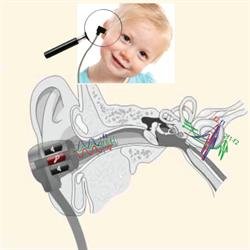Autism Risk Could be Identified Earlier by Simple Hearing Test

Characterized by restricted and repetitive behaviors and impairments in social-communication skills, Autism Spectrum Disorder (ASD) is a neurodevelopmental disorder that is often not diagnosed until after age four. Although many signs of ASD are present before age two, most tests for ASD rely on speech. This makes them ineffective in children who are very young, or who have communication delays. As a result, corrective therapies are started later, delaying their potential impact.
Research findings that were published in the journal Autism Research report an inner ear deficiency in children with Autism. This may negatively affect their ability to recognize speech. These findings could eventually be used as a way to identify children at risk at an early age.
Anne Luebke, Ph.D., an associate professor in the University of Rochester Medical Center Departments of Biomedical Engineering and Neuroscience, and a co-author of the study notes that young children can now be screened for hearing deficits that are associated with autism with a simple, safe, and non-invasive method. Clinicians using this technique will be able to intervene earlier and help achieve optimal outcomes in treating the disorder.
Finding a way to detect the risk of ASD in young children is challenging, as the earliest and consistent signs of ASD involve auditory communication. These tests rely on speech, and are often ineffective in children who have communication delays or are very young.

Simple hearing test may be able to identify Autism risk (Image credits: University of Rochester / A. Luebke)
A technique measuring otoacoustic emissions was used by researchers in the new study. Many newborns must undergo a similar test to check for hearing problems before leaving the hospital. Miniature speaker/microphone earplugs were used to measure hearing deficiencies. The scientists listen for signs that the ear is having difficulty processing sounds by detecting miniscule sound emission made by the outer hair cells of the inner ear in response to certain clicking sounds and tones. If the device fails to detect an emission, these cells are not functioning properly. This indicates that the inner ear or cochlear function is impaired.
The hearing of children between the ages of 6 and 17 was tested in the study. About half of the test group had been diagnosed with ASD, and the researchers found that these children had difficultly hearing in a specific frequency range (1-2 kHz). This range plays a big role in in speech processing. They also noted a strong correlation between the severity of ASD symptoms and the degree of cochlear impairment.
Loisa Bennetto, Ph.D., an associate professor in the University of Rochester Department Of Clinical and Social Sciences in Psychology, and a co-author of the study noted that developmental delay and other problems such as language deficits have long been associated with auditory impairment. Although there is no association between autism and hearing problems, problems in processing speech may contribute to some of the central symptoms of the disease. Early detection of hearing problems could help identify risk for ASD and that would enable clinicians to intervene earlier. These findings can also assist in the development of methods to correct auditory impairment with hearing aids, or other devices designed to improve the range of sounds the ear can process.
The team is currently exploring the possibilities that this technique could be adapted to screen infants, as it does not require the subject to respond verbally. In addition, the test is non-invasive and inexpensive.

Like what you read (without annoying ads :) ) ? Then please upvote our posts and follow us for the best daily science news on SteemIt!
I upvote U